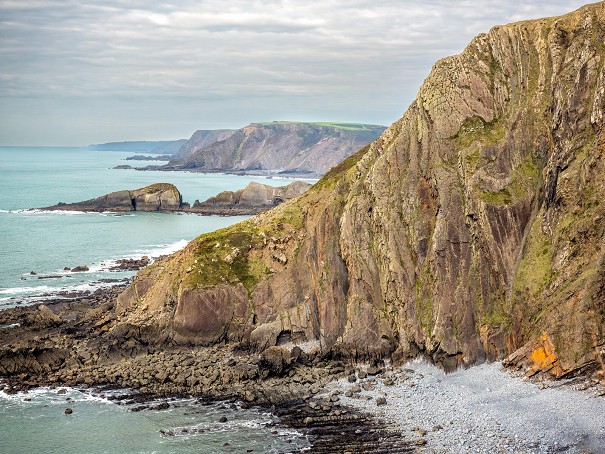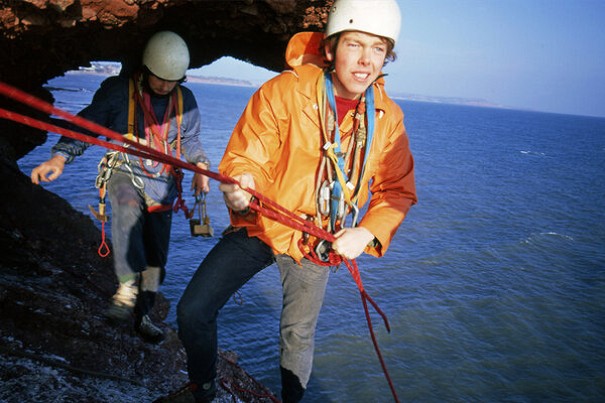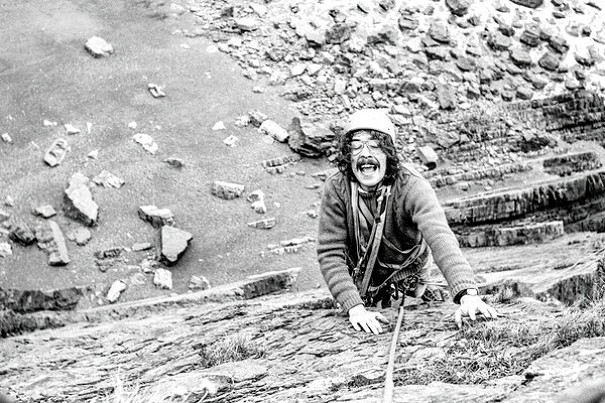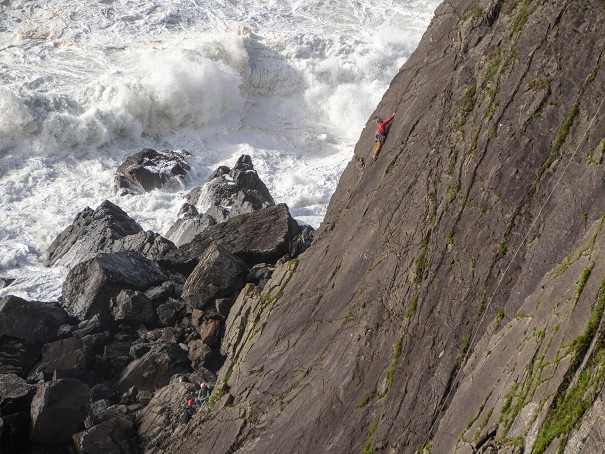
Culm Dancing: Voyages of Discovery (1976-1990)
My first experiences of climbing on the Culm Coast were in 1976, when I failed at half height on Mascon at Sharpnose and - later that day - climbed what I believed to be Notre Dame at Blackchurch, when in fact I'd climbed the smaller slab nearer the top of the beach. Two years later I visited Brownspear Point with a view to climb Berlin, but ended up inadvertently climbing a new route, Eric Pode's Route E2 5a/b, which eventually shared the same cataclysmic fate as Berlin. Later that year, myself and Brian Rossiter went to Dyer's Lookout with a view to doing the original Earth Rim Roamer, but couldn't identify what we saw with the guidebook description. It was a little while before we realised we were standing on it on the beach. This would not be the last time I experienced this phenomenon on this coastline.
In February 1979, on a cold dank day, myself and Martin Dunning visited Blackchurch and climbed Loose Woman E1 5b, Archtempter E3 5b and Barrabas VS 4c, which I led quickly whilst it fell down around me. I was getting a taste for the rock.
As a young non-climbing art student in 1972 I had spent a week in Hartland and had often walked along the beach from Hartland Quay to Damehole Point, so I could remember the topography, and in Spring 1979 decided to investigate the area in more detail. The first route completed was The Wine Dark Sea E1 5b at Damehole Point. This is a long traverse above high tide and a great fun climb as long as you get the tides right.
A few days later we were back and walked from Damehole to Smoothlands, climbing a few easy exploratory routes on the way. When I reached Smoothlands I couldn't believe my eyes to see a huge, intimidating, unclimbed cliff. Fired with enthusiasm, I climbed an obvious groove at the left edge of the Great Slab to give Generation Landslide E2 5a/b. This lasted less than a year before it fell down, thus giving my right foot the distinction of making the first ascent of Creeping Flesh E5 6b.
The next day we visited Dyer's Lookout and climbed a number of new routes including Blisterin' Barnacle E2 5b, the first part of which included using limpets as footholds (always remember to tap them first for maximum usefulness). A week later, Roger Mear and I parked the car at Hartland Quay and spotted the immaculate Landward Slab of Screda Point with the distinctive line of Tourist Trap E1 5b, which we climbed on sight. We also spotted the line of Half Life which we felt unable or unwilling to rise to the challenge of attempting.
I did a few routes with Pat Littlejohn in the early summer and he told me about Cow and Calf near Hartland Point, which I duly visited with Don Sargeant to climb The Sceptred Race HVS 5a, with Don rushing off to take photos from however far he could get from the cliff without pulling me off. A few weeks later I returned and climbed Tsunami E2 5b, with Nick Crowhurst and again Don did the honours with the camera.
Later that month I went to Blackchurch with Cathy Woodhead and I made an ascent of the fantastic Sacre Couer E2 5c. Sitting at the bottom afterwards I realised there was a potential line to its left. I was about two thirds of the way up the this when Cathy let me know that the tide had come in and she was gradually climbing up behind me whilst paying out the rope. I hastily took a dodgy belay on a single wire and brought her up, just as the sea was lapping at her feet. The route became Les Invalides E2 5c.
The summer of 1979 was highlighted for me by mine and Iain Peters' supposed discovery of Exmansworthy Cliff near Clovelly (Pat and Keith Derbyshire had, of course, already found it). We started out at Hartland Point and made a hazardous traverse along the boulder beach towards Blackchurch, passing Chapman Rock, which we realised would give a few routes. After about a mile we stood under the main cliff and were astonished to see so much rock and a plethora of cracks in what looked like reasonably solid rock. At this point we realised we had been cut off by the tide and our only recourse was to climb a route on-sight to get out which gave us Tactical Retreat HVS 4c. However the climb was the easy part of our journey to the top of the cliff as we then found ourselves in a huge earth crevasse (more on this later) which we had to negotiate. Once out of this we were confronted by a vicious, thick hawthorn hedge, which was eventually overcome by the expedient of me falling backward over the worst section whilst Iain clambered over me and then dragged me out. We returned and climbed the towering left-hand of the two grooves right of the slab to give Second Sight E2 5a, which turned out to be poor man's Archtempter. Climbing at Exmansworthy was not for the faint hearted. It required a 300 feet abseil to get in and some jumaring up collapsing vertical walls and called for a certain sang froid. A few more routes were climbed there before the end of the year including the magnificent Cat Burglar E3 5c. The next year would be a bumper year for new routes on the Culm.
In March 1980, I went back to Screda Point with Chris Gibson and on a cold damp day led Half Life E3 5c. I couldn't get any protection after the halfway point. There were no micro wires available then and I was also wearing EBs, which weren't any good on smears. I reached the top in a barely controlled state of terror. In April I was back at Exmansworthy with the late Renny Croft cleaning and climbing Hand Job E1 5b, so named because you started the climb on finger jams and end it by arm jamming; the total hand/arm experience. I later climbed the beguiling crack branching off right at half height to give Iron Fist E3 5c. Later that day we climbed Chein Lunatique HVS 5a at Screda Point.
The May Bank Holiday saw a big, jolly team from Alpine Sports in Holborn laying siege to the crag. Rod Pawsey and I climbed Shadow Walker E3 5c, 6a. I had done the top pitch the previous year after traversing in from the left, using a point of aid on the 6a move off the belay. This time I straightened it up with a fantastic direct start and without using the aid. It was a fabulous route, a Southwest classic. It wasn't destined to be that for very long as sometime in the early 90's the top 40 feet fell down, a great loss. Other routes followed that year after manic trips from London, most notably Sheepdog Trials in Babylon E2 5c at Exmansworthy and Carriatid E2 5c at Cow and Calf - both good routes. On Sheepdog Trials, which is one long pitch, I reached the very last move onto the sloping belay ledge, with my last runner some way below, to be confronted with a sloping ledge covered in small ball bearing like stones. I scrabbled around and ended up falling about 50 feet down the wall. Renny Croft had scrambled unroped up a grassy rake on the right of the slab and was on the belay ledge taking photos but he very quickly moved back out of range as I momentarily eyed up grabbing his leg. Undaunted, I climbed back up and finished it.

In 1981, after failing on an attempt at King's Arete at Tintagel, we made our way back to London via Blackchurch. After a few falls I succeeded on Jamaican Dub E3 6a - a route I had been eyeing up for a while. Once again I had no micro wires and was wearing EBs. After I had done the crux at about a third height I had a long, lonely and frightening journey to the top. A footnote to this ascent was my returning in 1983 to repeat it, finding that the tiny flakes at the crux had been improved by chipping and a peg had been placed, which I removed.
In 1982 just prior to a lengthy sojourn in the US, Renny Croft, Dicky Swinden and I made a week-long trip to Devon which involved us in a bit of a new route frenzy.
At Screda I tiptoed across Naughty Sneaky E2 5b, which is an entertaining left to right traverse of the Landward Slab and a smearing tour de force. Dicky found One in Every Port E2 5c, another excellent route. The next day I led The King of Snee E2 5b, a big pitch on the large slab left of the Shadow Walker slab - another route destined to never have a second ascent.
1984 was a big year for me on the Culm Coast, starting with a visit to Cornakey. We had driven there in the face of torrential rain and hopes were not high for any climbing but astonishingly the rain stopped at the A39 and we had a dry day on the crag. Cornakey is renowned for the classic Wrecker's Slab VS 4c, but my eye had been drawn to the smaller but considerably more solid smaller seaward slab. The obvious crack on the left gave Stormy Weather HVS 5a and the thinner crack just right gave the excellent Sunday Bloody Sunday E2 5c - a little gem. To finish a tremendous day, we climbed Wreckers to get out.
At roughly the same time, a visit to Exmansworthy resulted in Reefer Madness E1 5b on the far right hand slab set high above the beach. A line to the left later gave Chase the Dragon E3 5c. Unbelievably a friend from Plymouth, Kevin Tole, had hitch hiked up, walked the boulder beach from Hartland Point and then climbed a 100 feet of utter death defying choss to suddenly appear below the start of the climb, much to mine and Don Sargeant's astonishment. We gave him a lift home and bought him a pint to reward his valour. In June a group of us had a beach barbecue somewhere just south of Speke's Mill Mouth and the next morning saw a group of bedraggled, bleary eyed zombies negotiate the treacherous track to the crag and set about making an ascent of Pressure Drop E3 5c. This is the sinuous crack line in the wall right of the waterfall which had repulsed me the previous weekend when the final crack was choked with compacted earth. I abseiled down to clean it and set up a belay in the stream at the bottom, which has to be something of a unique feature of the route. The first 40 feet is rather loose but is not difficult, then a tricky move gains the crack from where good holds and protection lead up the steepening crack to a dynamic finish. A three star route and an absolutely memorable experience.
Two weeks later, I slept at the top of Smoothlands in order get up very early to clean a line at the highest point of the cliff where a line of weakness offered the possibility of an adventure. Martin Doyle arrived just as I finished. The first part is a gradually steepening slab/wall of about 30 feet to reach an overhang, just above which I had placed a peg. I had just clipped this when the hold I was using snapped and I fell off. Another 50 foot of climbing on creaky holds led to a belay where I brought Martin up, then he carried on up another bold and sparsely protected long pitch to the top. The resulting route was World's Weird Wall E3 5b, a proper Culm Coast adventure in its truest style.
January 1985 saw Don Sargeant, Martin Dunning and myself visiting Vicarage Cliff, an attractive slab seemingly plastered in holds. During a snowstorm we managed to climb a number of routes of which the best was the minor classic Box of Delights, HS 4a.
At Brownspear Point in March, during more snowstorms, I led led Tetrapod E3, with Julian Barber. It is an immaculate, well protected crackline in a vertical wall near the sea. Julian led the crackline leading out of a niche to the left to give Parallel Flow E2 5b another good route which gets people thinking.
During the summer I climbed Easter Risings E3 5c at Compass Point, which on the first ascent led to a very bold piece of climbing up the wall and arete left of the corner of Caravanserai. The top 50 feet was unprotected and felt very serious. I returned in 1990 and found much to my surprise and relief that the top 30 feet had slumped back by about 10 degrees and left a convenient horizontal crack which I stuffed with gear. Unfortunately, this area of cliff has now become so unstable that climbing there may prove to be most unwise.
Later that year I returned to Exmansworthy with Iain Peters to look at the big wall left of King of Snee. Negotiating the crevasse and unstable ground to reach the top of the cliff in order to set up an abseil rope was exciting to say the least. With the cleaning finished Iain strapped himself onto a belay in a cleft just above the advancing tide while I led up the wall. For about 40 feet it was reasonable but the holds dried up and I was left looking at a very bald piece of climbing up to a narrow overlap, above which I had pre-placed a peg. I placed a couple of psychological micro wires and set about the crux. Next thing I knew I falling about 45 feet down the cliff ripping the wires out and dragging Iain out of his cocoon and onto the wall above the water. Luckily one piece of gear held and I went back up to try again. This time the result was the same. Once again I climbed up expecting the same result but to my utter astonishment, I made it to the overlap where I clipped the peg with great relief. I named the route Smooth Operator and graded it E4 6a but it was probably more realistically E5. A few years later I returned to do Shadow Walker and found to my dismay that the whole cliff had fallen down without either of the routes having been repeated. Bizarrely I had a look to see if I could find any of the pegs I had left in place.
There is an epilogue to this ascent. Two friends (who will remain nameless) had kayaked to the crag from Blackchurch but when it came time for them to return, the sea had got choppy and they were reluctant to paddle back with the gear. They told us that the coast path was level all the way to Blackchurch so we took them at their word and carried all our gear and theirs back to the top which in its own right was an epic, involving having to jumar up 300 feet of fixed ropes. When we got to the top, we followed the coast path towards Blackchurch only to find that it descended sharply to about 60 feet from the beach and equally sharply back up again. By the time we reached the woods above Blackchurch, it was completely dark and we had to blunder our way down through the trees with much swearing and falling over dead trees and roots. It is adventures like this which to my mind make climbing on the Culm Coast such an alluring and challenging prospect.
After Martin Doyle and I had finished World's Weird Wall in 1984, we abseiled down the obvious line of weakness on the left of The Great Slab which was the line of the collapsed Generation Landslide. We reckoned it would go but didn't fancy it then. Two years later I returned with Pat Parsons to attempt an ascent. To warm up, I cleaned and climbed a route on the wall right of the final pitch of Flight Path XS 5a/b. The result was a technical piece of climbing up a sinuous crack line in a fantastic position. I named it Open Day E3 6a; Pat should have been at an open day at the Marine training camp at Lympstone in Devon. After this, we geared up to make an attempt on the unclimbed line but just as I was about 10 feet up it started raining. Anyone conversant with climbing on the Culm knows that it dries out very quickly so we sat down to wait for the rain to stop. An hour later it was still raining and our resolve had weakened so we left. I never went back and the next year saw Ken Palmer and Pete Saunders sweep in and make the ascent of the brilliant Creeping Flesh E5 6b.
I have done many more new routes on the Culm, but with the exception of Nirex E5 6a at Screda Point, 1986 was effectively the end of my concentrated explorations on the Culm Coast as my attention switched to the Lizard and West Penwith. I would like to think that these great experiences were following closely in the footsteps of the original pioneers such as Hazelton, Patey, Lawder, Darbyshire and Littlejohn who set the adventurous standards which make climbing on this coastline such an exciting and life affirming experience. The wildness and stark beauty of some of the venues draws one in and the adventures it offers richly reward those who seek out its pleasures. I once spent a year in the Pacific Northwest of the USA and I vividly remember feeling an immense sense of nostalgia for the coastline whilst I was sitting on a beach in Alaska looking out over the vastness of the Pacific Ocean. The experiences I had on the Culm were seared indelibly into my memory. Climbing on this coast is no mere athletic activity shorn of romance and adventure but a truly overwhelming sensual experience, which is really why I became involved in climbing in the first place.
Whilst I cannot climb these days because of health issues I continue to be fascinated by cliffs, mountains and rock and these subjects make up a large part of my work. My paintings mainly relate to different aspects of landscape, particularly the close examination of texture, surface qualities and the structural grandeur of both large and small environments. 35 years of rock climbing has given me ample time, whilst sat on belay ledges, and walking to venues, to admire the scenery and detail of my surroundings. I am glad to have the opportunity to remain engaged, in a constructive way, with the outdoors.
To see more of Pete O'Sullivan's artwork visit peteosullivanartist.co.uk



























